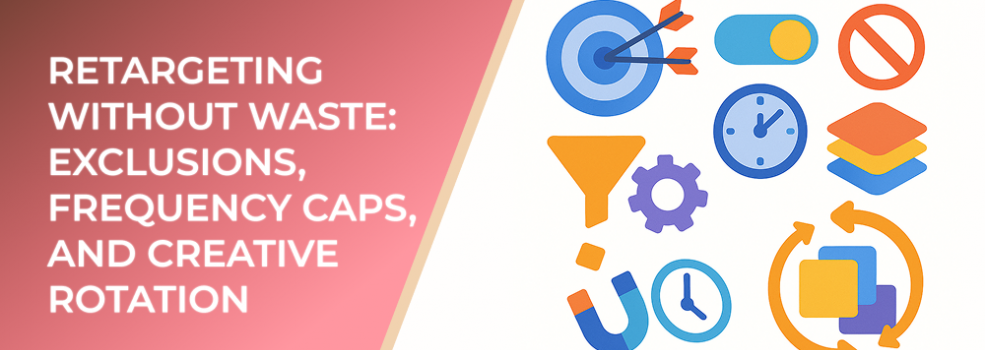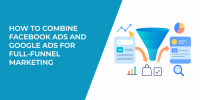Retargeting should convert warm intent at an efficient CPA—but without guardrails it can spiral into overspend, audience fatigue, and reduced ROAS. This guide explains the three pillars of waste‑free retargeting:
-
Exclusions that keep the wrong people out,
-
Frequency caps that protect attention and margin,
-
Creative rotation that maintains freshness and relevance.
Why Retargeting Waste Happens
-
Audience overlap: prospecting, remarketing, and lifecycle audiences compete for the same users, inflating frequency and CPMs.
-
Stale pools: people who converted, churned, or aged out of the funnel remain targetable.
-
Narrow creatives: the same ad repeats past the point of diminishing returns.
Impact in numbers:
-
Accounts that implement layered exclusions typically reduce retargeting spend by 15–30% with no loss in conversions.
-
Keeping average frequency ≤ 6–8 per 7 days on small pools correlates with 10–20% lower CPA versus uncapped delivery.
-
Rotating at least 3–5 active creative concepts can add +8–18% CTR and slow CPM inflation.
Pillar 1 — Exclusions: Who Not to Show Ads To
Essential Exclusions
-
Recent converters: exclude purchasers for 30–90 days based on replenish cycle or onboarding.
-
Refunders/chargebacks: remove for 180 days; prevents negative ROAS loops.
-
Low‑intent bounces: exclude sessions with <10s time‑on‑site or single‑page bounces from conversion‑optimized sets.
-
Employees, agencies, affiliates, test accounts: maintain a constantly updated suppression list.
Smart Segment Logic
-
Use mutually exclusive stages: Prospecting → Engaged Visitors → Cart/Lead → New Customers → Existing Customers. Make sure each stage excludes downstream states.
-
Apply recency windows: e.g., Cart Abandoners 0–7 days, 8–30 days with softer offers, then sunset.
Benchmarks
-
Expect list shrink of 10–20% after proper exclusions—and a net CPA improvement from reduced waste.
Pillar 2 — Frequency Caps: How Much Is Too Much?
Guardrails
-
Prospecting: cap ≤ 6–8 impressions / 7 days.
-
Remarketing (mid‑funnel): cap ≤ 8–12 / 7 days depending on AOV and consideration length.
-
Cart/Lead Recovery: short bursts allowed, but monitor daily frequency ≤ 3–4 with tight recency windows.
Monitoring
-
Track Impressions / Reached Users by ad set. Watch for rising CPM + frequency with flat CTR—classic fatigue.
-
If frequency > cap for 2 consecutive weeks, tighten caps or expand audience with recency windows.
Expected Impact
-
Right‑sized caps maintain delivery while reducing annoyance and ad blindness, often unlocking 10–15% ROAS gains on small pools.
Pillar 3 — Creative Rotation: Keep It Fresh
Working Cadence
-
Maintain 3–5 concepts live per key audience.
-
Refresh weekly in high‑spend cycles; bi‑weekly otherwise.
-
Vary format and angle: product proof, social proof, explainer, offer, UGC‑style, and motion variants.
Fatigue Signals
-
CTR down 25% from baseline for 7 days.
-
View‑through conversions fall while frequency climbs.
-
Comments sentiment tilts negative or repetitive.
What to Keep
-
Archive winners by concept ID; re‑skin successful angles (copy/visuals) rather than reinvent from scratch.
Useful Stats & Operating Targets
-
Frequency caps: ≤ 6–8 (prospecting), ≤ 8–12 (remarketing), ≤ 3–4/day (cart/lead recovery).
-
Exclusion coverage: target > 95% of recent converters removed from remarketing sets within 24–48 hours.
-
Creative diversity: ≥ 3 concepts active per audience; swap when CTR drops > 25% from 14‑day median.
-
List recency mix: 40–60% of remarketing pool added in the last 60 days.
LeadEnforce Workflow
-
Build clean segments: import CRM/orders/leads, then create mutually exclusive audiences (site visitors, cart/lead, new customers, existing customers).
-
Automate exclusions: sync “recent buyers,” “refunds,” and “employees/test” as suppression lists across platforms.
-
Set refresh schedules: weekly for high‑velocity sources; monthly for slow, maintaining rolling windows (e.g., last 90 days).
-
Monitor hygiene & overlap: deduplicate across sources; analyze audience intersections to prevent double‑serve.
-
Versioning: tag ad concepts and map them to audiences for rigorous rotation.
30/60/90‑Day Plan
Days 0–30
-
Stand up core exclusions and basic caps.
-
Launch 3 creative concepts per key stage.
-
Baseline CPA, frequency, CTR, and overlap.
Days 31–60
-
Tighten recency windows and add stage‑specific caps.
-
Introduce recovery sequences (0–7, 8–30 day logic).
-
Expand creative library; promote top performers.
Days 61–90
-
Implement automated refresh and cross‑channel suppression.
-
Add value‑based customer segments (high LTV, repeat purchasers).
-
Formalize a weekly fatigue review and quarterly exclusion audit.
Troubleshooting
-
High frequency, flat conversions: reduce caps, widen audience recency, or rotate creatives; check overlap between ad sets.
-
CPA spikes after exclusions: confirm attribution windows; ensure exclusions aren’t removing mid‑funnel prospects prematurely.
-
Small audience delivery issues: aggregate adjacent windows (e.g., 0–7 + 8–30 days) or expand placements while keeping caps.
KPI Checklist (copy/paste)
-
Exclusions synced in last 48h; coverage > 95% of new converters
-
Avg frequency within caps for each stage
-
≥ 3 active creative concepts per audience
-
CTR within 15% of 14‑day median (or better)
-
Recency mix: ≥ 40% added in last 60 days
-
Overlap analysis shows minimal double‑serve
Suggested Reads from the LeadEnforce Blog
-
Why Custom Audiences Shrink Over Time (and How to Rebuild Them)
-
Audience Hygiene 101: Formatting, Hashing, and Deduplication Best Practices
Takeaway
Waste‑free retargeting is a system: exclude what doesn’t convert, control exposure with frequency caps, and keep messages fresh through rotation. With disciplined guardrails and LeadEnforce automation, you can preserve margins, improve ROAS, and scale confidently.

